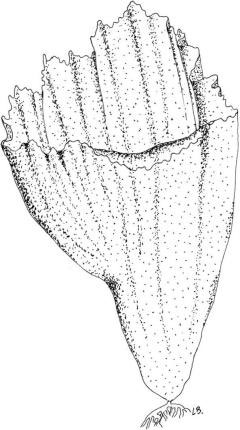Chlorophyta
Monostroma (Figure 7.9) and Enteromorpha (Figure 7.10) are the two green macroalgae genera cultivated in Japan, and known as aonori or green laver.
Monostroma latissimum occurs naturally in the bays and gulfs of southern areas of Japan, usually in the upper eulittoral zone. The fronds are bright green in color, flat and leafy, consisting of a single cell layer. They are slender at the holdfast and growing wider toward the apex, often with a slight funnel shape that has splits down the side. Monostroma reproduces seasonally, usually during tropical dry season or temperate spring. It is found in shallow sea water usually less than 1 m in depth; generally grows on rocks, coral, mollusk shells, or other hard substrates, but also grows as an epiphyte on sea plants including crops such as Kappaphycus and Eucheuma.
It can thrive in both salt and brackish waters and is usually found at the top of the sublittoral zone. It contains about 20% protein, little fat, low sodium, and high iron and calcium. Its vitamin B-group content is generally higher than most vegetables, and while its vitamin A is high, it is only half of that found in spinach. Its life history involves an alternation of generations with the same appearance of long, tubular filaments. As for Monostroma, rope nets are seeded with spores by submerging them in areas where Enteromorpha is growing naturally.
Ulva sp. is known as sea lettuce, as fronds may be convoluted and have an appearance rather like lettuce. It can be collected from the wild and added to Monostroma and Enteromorpha as part of aonori. It has a higher protein content than the other two, but much lower vitamin content, except for niacin, which is double that of Enteromorpha. Bright green in color, it has a double or multiple cell layer. Slender at the holdfast and growing wider toward the apex, it reproduces seasonally, usually during tropical dry season or temperate spring. It is naturally found in shallow sea water usually less than 1 m in depth, where it grows on rocks, coral, mollusk shells, or other hard substrate, but also as an epiphyte on other sea macroalgae. It was used as flavoring with other seaweed by Kashaya Pomo natives of northern California.
Caulerpa lentillifera (Figure 7.11) and Caulerpa racemosa are the two edible green algae used in fresh salads and known as sea grapes or green caviar. As the common name suggests, their appearance looks like bunches of green grapes. These algae often produce “runners” under the substrate, which can produce several vertical branches that extend above the substrate. They naturally grow on sandy or muddy bottom in shallow protected waters.
Planting is done by hand; about 100 g lots are pushed into the soft bottom at 0.5–1 m intervals. Harvesting can commence about 2 months after the first planting; fronds are pulled out of the muddy bottom, but about 25% of the plants are left as seed for the next harvest. Depending on growth rates, harvesting can then be done every 2 weeks. The harvested plants are washed thoroughly in seawater to remove all sand and mud, then sorted and placed in 100–200 g packages; these will stay fresh for 7 days if chilled and kept moist. Table 7.5 summarizes edible algae and the corresponding food item.








